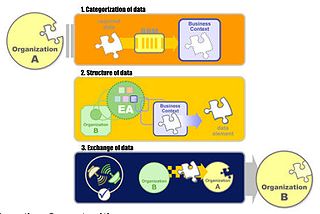
Data Reference Model
Encyclopedia

Federal Enterprise Architecture
A federal enterprise architecture is the enterprise architecture of a federal government. It provides a common methodology for information technology acquisition, use, and disposal in the Federal government....
(FEA).
Overview
The DRM is a framework whose primary purpose is to enable information sharing and reuse across the United States federal government via the standard description and discovery of common data and the promotion of uniform data management practices. The DRM describes artifacts which can be generated from the data architectures of federal government agencies. The DRM provides a flexible and standards-based approach to accomplish its purpose. The scope of the DRM is broad, as it may be applied within a single agency, within a Community of Interest (COI)1, or cross-COI.DRM structure
The DRM provides a standard means by which dataData
The term data refers to qualitative or quantitative attributes of a variable or set of variables. Data are typically the results of measurements and can be the basis of graphs, images, or observations of a set of variables. Data are often viewed as the lowest level of abstraction from which...
may be described, categorized, and shared. These are reflected within each of the DRM’s three standardization areas:
- Data Description: Provides a means to uniformly describe data, thereby supporting its discovery and sharing.
- Data Context: Facilitates discovery of data through an approach to the categorization of data according to taxonomies. Additionally, enables the definition of authoritative data assets within a COI.
- Data Sharing: Supports the access and exchange of data where access consists of ad-hoc requests (such as a query of a data asset), and exchange consists of fixed, re-occurring transactions between parties. Enabled by capabilities provided by both the Data Context and Data Description standardization areas.
DRM Version 2
The Data Reference Model version 2 released in November 2005 is a 114 page document with detailed architectural diagrams and an extensive glossary of terms.The DRM also make many references to ISO standards specifically the ISO/IEC 11179
ISO/IEC 11179
ISO/IEC 11179 is an international standard for representing metadata for an organization in a metadata registry.- Intended purpose :...
metadata registry standard.
DRM usage
The DRM is not technically a published technical interoperability standard such as web services, it is an excellent starting point for data architects within federal and state agencies. Any federal or state agencies that are involved with exchanging information with other agencies or that are involved in Data warehouseData warehouse
In computing, a data warehouse is a database used for reporting and analysis. The data stored in the warehouse is uploaded from the operational systems. The data may pass through an operational data store for additional operations before it is used in the DW for reporting.A data warehouse...
ing efforts should use this document as a guide.
See also
- Enterprise Architecture framework
- Enterprise Application IntegrationEnterprise application integrationEnterprise Application Integration is defined as the use of software and computer systems architectural principles to integrate a set of enterprise computer applications.- Overview :...
- Enterprise Service BusEnterprise service busAn enterprise service bus is a software architecture model used for designing and implementing the interaction and communication between mutually interacting software applications in Service Oriented Architecture...
- Federal Enterprise ArchitectureFederal Enterprise ArchitectureA federal enterprise architecture is the enterprise architecture of a federal government. It provides a common methodology for information technology acquisition, use, and disposal in the Federal government....
- ISO/IEC 11179ISO/IEC 11179ISO/IEC 11179 is an international standard for representing metadata for an organization in a metadata registry.- Intended purpose :...
- Metadata publishingMetadata publishingMetadata publishing is the process of making metadata data elements available to external users, both people and machines using a formal review process and a commitment to change control processes....
- Semantic spectrumSemantic spectrumThe semantic spectrum is a series of increasingly precise or rather semantically expressive definitions for data elements in knowledge representations, especially for machine use.At the low end of the spectrum is a simple binding of a single word or phrase and its...
- Semantic WebSemantic WebThe Semantic Web is a collaborative movement led by the World Wide Web Consortium that promotes common formats for data on the World Wide Web. By encouraging the inclusion of semantic content in web pages, the Semantic Web aims at converting the current web of unstructured documents into a "web of...
- Synonym RingSynonym ringIn metadata a synonym ring or synset, is a group of data elements that are considered semantically equivalent for the purposes of information retrieval. These data elements are frequently found in different metadata registries...

